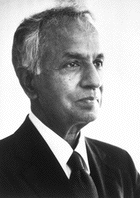Subrahmanyan Chandrasekhar
Subrahmanyan Chandrasekhar (19 October 1910 – 21 August 1995) was an Indian-American astrophysicist who made significant contributions to the understanding of stellar evolution, structure, and dynamics. He is best known for his theoretical work on the physical processes of stellar objects and for the Chandrasekhar limit, a fundamental principle in the theory of stellar evolution. This limit, named after him, describes the maximum mass of a stable white dwarf star.
Early Life and Education[edit | edit source]
Subrahmanyan Chandrasekhar was born in Lahore, British India (now in Pakistan), into a Tamil family. He was the nephew of C.V. Raman, a Nobel Laureate in Physics. Chandrasekhar pursued his undergraduate degree at Presidency College, Madras (now Chennai), where he was exposed to the works of British astrophysicist Sir Arthur Eddington. Inspired by Eddington's book "The Internal Constitution of the Stars", Chandrasekhar decided to focus his research on astrophysics. In 1930, he was awarded a Government of India scholarship to pursue graduate studies at the University of Cambridge in England, where he earned his PhD under the supervision of Ralph H. Fowler.
Career and Contributions[edit | edit source]
After completing his PhD, Chandrasekhar held positions at the University of Cambridge, and later at the University of Chicago, where he spent most of his career. During his tenure, he made groundbreaking contributions to the fields of astrophysics and applied mathematics. His early work on the structure and evolution of stars led to the discovery of the Chandrasekhar limit in 1931. This theoretical limit (approximately 1.4 times the mass of the Sun) predicts that stars with a mass greater than the limit would not become white dwarfs but would instead continue to collapse, potentially becoming neutron stars or black holes.
Chandrasekhar's research also covered a wide range of topics including the theory of radiative transfer, the stability of ellipsoidal figures of equilibrium, and magnetohydrodynamics. He was instrumental in developing the mathematical theory of black holes and was one of the first scientists to propose the existence of black holes as a mathematical certainty.
Awards and Honors[edit | edit source]
Subrahmanyan Chandrasekhar received numerous awards and honors throughout his career, including the Nobel Prize in Physics in 1983, which he shared with William A. Fowler for their studies of the physical processes important to the structure and evolution of stars. Other notable awards include the Bruce Medal, the Gold Medal of the Royal Astronomical Society, and the National Medal of Science.
Legacy[edit | edit source]
Chandrasekhar's work has had a profound impact on the field of astrophysics, influencing the understanding of stellar dynamics, white dwarfs, and black holes. The Chandrasekhar limit remains a fundamental concept in the study of stellar evolution. In honor of his contributions, the Chandra X-ray Observatory, launched by NASA in 1999, was named after him. Chandrasekhar's legacy continues to inspire astronomers and astrophysicists around the world.
Selected Works[edit | edit source]
Some of Chandrasekhar's most influential works include:
- An Introduction to the Study of Stellar Structure (1939)
- Principles of Stellar Dynamics (1942)
- Radiative Transfer (1950)
- Hydrodynamic and Hydromagnetic Stability (1961)
Death[edit | edit source]
Subrahmanyan Chandrasekhar passed away on 21 August 1995 in Chicago, Illinois, USA, leaving behind a legacy that continues to influence the fields of physics and astrophysics.
Search WikiMD
Ad.Tired of being Overweight? Try W8MD's physician weight loss program.
Semaglutide (Ozempic / Wegovy and Tirzepatide (Mounjaro / Zepbound) available.
Advertise on WikiMD
|
WikiMD's Wellness Encyclopedia |
| Let Food Be Thy Medicine Medicine Thy Food - Hippocrates |
Translate this page: - East Asian
中文,
日本,
한국어,
South Asian
हिन्दी,
தமிழ்,
తెలుగు,
Urdu,
ಕನ್ನಡ,
Southeast Asian
Indonesian,
Vietnamese,
Thai,
မြန်မာဘာသာ,
বাংলা
European
español,
Deutsch,
français,
Greek,
português do Brasil,
polski,
română,
русский,
Nederlands,
norsk,
svenska,
suomi,
Italian
Middle Eastern & African
عربى,
Turkish,
Persian,
Hebrew,
Afrikaans,
isiZulu,
Kiswahili,
Other
Bulgarian,
Hungarian,
Czech,
Swedish,
മലയാളം,
मराठी,
ਪੰਜਾਬੀ,
ગુજરાતી,
Portuguese,
Ukrainian
Medical Disclaimer: WikiMD is not a substitute for professional medical advice. The information on WikiMD is provided as an information resource only, may be incorrect, outdated or misleading, and is not to be used or relied on for any diagnostic or treatment purposes. Please consult your health care provider before making any healthcare decisions or for guidance about a specific medical condition. WikiMD expressly disclaims responsibility, and shall have no liability, for any damages, loss, injury, or liability whatsoever suffered as a result of your reliance on the information contained in this site. By visiting this site you agree to the foregoing terms and conditions, which may from time to time be changed or supplemented by WikiMD. If you do not agree to the foregoing terms and conditions, you should not enter or use this site. See full disclaimer.
Credits:Most images are courtesy of Wikimedia commons, and templates, categories Wikipedia, licensed under CC BY SA or similar.
Contributors: Prab R. Tumpati, MD

